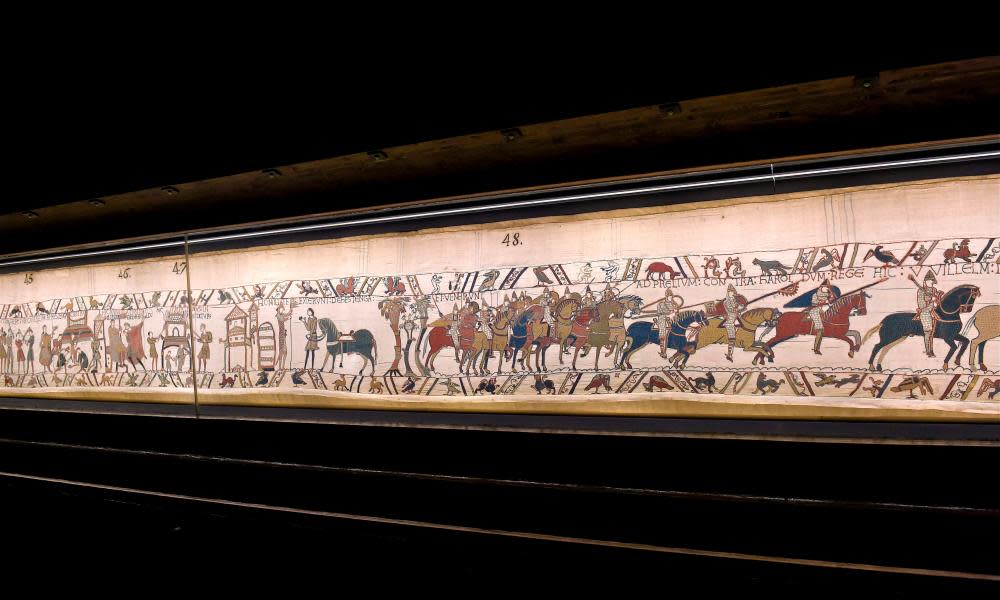The Bayeux Tapestry shows Britain’s birth as a European nation

As a British-born, adopted Norman, I am delighted that the Bayeux Tapestry may be going on a short holiday to Britain after 952 years. The tapestry (actually an embroidery) is a remarkable and remarkably modern piece of art. It is often described as the “first strip cartoon” and the “first movie storyboard”. Less frequently observed is the fact that it preceded television 24-hour news channels by nine centuries in its neat use of scroll bars to provide extra information above and below the main action.
I would like, however, to correct a common misconception. The tapestry does not tell the story of the “last time this country was invaded and subjugated” as Robert Peston suggested in a tweet. Others made similar comments, claiming that the proposed loan of the tapestry was a “Gallic joke”.
This is silly. We are not Anglo-Saxons. Taking England alone, and leaving aside the rest of the United Kingdom, the Bayeux Tapestry portrays our invasion of ourselves. England in the 21st century is racially and culturally the product of many things but we owe as much to William’s Normans as to Harold’s Anglo-Saxons.
If you live in Normandy as I mostly do (about 20 miles from Bayeux), you are reminded of this fact daily. You see it in your neighbours’ faces, in the architecture, in the soft beauty of the countryside. England, especially southern England, is part of a Greater Normandy. We are a Norman colony which has surpassed its motherland, just as the United States has surpassed the United Kingdom. My next-door neighbour, Madeleine, Norman for many generations, is a dead-ringer for Dandy Nichols, the actor who played Alf Garnett’s wife in the 1960s sitcom Till Death Us Do Part. Her husband, Michel, also Norman for generations, looks like a police sergeant or army corporal from a British film of the 1950s.
If you stare at a Norman supermarket queue, you will find some irretrievably French faces, but most Normans would pass unnoticed in Manchester or Brighton. Many English churches look like Norman churches. Many Norman farmhouses look like southern English farmhouses. Our supple and beautiful language is rooted in Anglo-Saxon – but it became supple and beautiful when it was interbred with Norman French.
Nonetheless, we persist in thinking of ourselves as the cultural descendants of the Anglo-Saxons, rather than the Normans, a case of mistaken self-identity that has profound consequences almost a millennium later. William’s conquest was the founding act of our “Brentry” into European culture and politics. This is a truth that we have refused to internalise. A classic and telling example is the Latin inscription over the biggest British war cemetery in Normandy, situated on the edge of Bayeux, a mile or so from the home of the tapestry. The inscription reads: “Nos A Gulielmo Victi Victoris Patriam Liberavimus”, or, “We, who were once conquered by William, have now liberated the conqueror’s native land.”
This is moving but wrong. The British troops who invaded Normandy on 6 June 1944 were not, as implied, the descendants of Harold’s army at Hastings. Leave aside the many Scots and Welsh and Irish soldiers, not to mention those soldiers of colour. The English participants on D-Day were as much descendants of William’s victorious army as Harold’s defeated one. You only have to look at the names on the graves in the cemetery. There are many Anglo-Saxon names but also scores that have Norman origins: Elliot, Hay, Forrester, Sage, Russell, Talbot. Even Montgomery is a Norman name – the field marshall was liberating his ancestors’ homeland.
The tapestry is therefore truly “coming home”. It was long thought to have been sewn by the ladies in waiting of Queen Matilda, William’s formidable spouse who ruled Normandy in his absence. It is now generally believed to have been sewn by Anglo-Saxon noblewomen in Kent, on the command of William’s half-brother, Odo, the bishop of Bayeux.
It has been in Bayeux ever since the 11th century, apart from a brief period when it was stolen by the Gestapo in 1944, then recovered in Paris and displayed in the Louvre in 1945. Its return to Britain after 950 years should not be seen as a “Gallic joke” to remind us of the last time we were invaded and subjugated. It should be seen as the rediscovery – too late, perhaps – of our birth certificate as a European nation.
Maybe that is what Emmanuel Macron had in mind.
• John Lichfield is a journalist based in France

 Yahoo News
Yahoo News 
